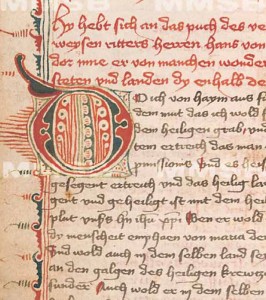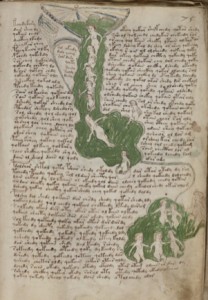http://midequalitygroup.co.uk/events/2031-05-29/ Introduction
 Der Neusohler Cato, a compendium of literature created in the 15th century, includes script that is similar to some of the handwriting on the last page of the Voynich Manuscript, as well as an example of symbolic encipherment.
Der Neusohler Cato, a compendium of literature created in the 15th century, includes script that is similar to some of the handwriting on the last page of the Voynich Manuscript, as well as an example of symbolic encipherment.
A few examples have been described in a previous blog post titled Medieval Mindsets. In it, I showed an example of a torn fragment at the beginning of Der Neusohler Cato that illustrates the progression of a word into a symbol (a form of encipherment) and how the main text of the Cato has strong similarities to the text on the last page of the Voynich Manuscript.
The similarity brings up many questions, one of which is, “Where was Der Neusohler Cato created?” If the handwriting is similar to the hand at the end of the VM, could the writer who notated the VM be from the same area, the same family, or have learned handwriting from the same teacher as the writer of the Cato manuscript?
http://kyleschen.com/tag/snooki-gets-punched/ Banská Bystrica
The Cato manuscript originated in Banská Bystrica, a historical mining town. It is a region of Bohemia with mountains, caves, and many spas. Many different ethnic groups have occupied the area over the centuries. It was granted township by King Béla IV in the mid-13th century when it was primarily a Slavic community but its mining history dates back thousands of years. Schools were established around the same time the township was recognized.
A significant number of German settlers immigrated to Banská Bystrica to seek jobs in the mining industry. Neusohl (Neu Sohl) is the German name for the town.
Der Neusohler Cato is handwritten in German script. Political borders around Banská Bystrica have changed many times, it was once part of Hungary, but it is currently in central Slovakia.
Topography
I’ve often wondered if the Voynich author lived in, or perhaps travelled to, a region of mountains and caves, based on the lofty escarpments in the “Map Section” and the abundance of bathing belles and grottos in the Voynich Manuscript.
Banská Bystrica, if it is in any way connected to the Voynich Manuscript, certainly fits the bill. It is a treasure trove of caves, many as yet undiscovered, within which are breathtaking grottos, stalactites, green underground pools, and water reservoirs historically used by castle inhabitants. There are currently many spas in the region.
Also, as might be expected in or around a mining town, there are ornate metalworks dating back to before the 16th century—items that might have inspired the tall ornate vessels in the “Kitchen Section” (called by some the “Pharmaceutical Section”).
We do not know the exact origin of the Voynich Manuscript. The best guess so far is that it came into the hands of Emperor Rudolph II and made its way, through other sets of hands, to the Villa Mondragone, near Rome, where it was purchased by Wilfred Voynich.
Holy Roman Emperor Rudolph II was king of the Bohemian regions in the late 1500s, in the same general area as Banská Bystrica. Rudolph was an avid patron of the arts and kept an extensive library. His castle in Prague was less than 400 miles from Banská Bystrica. It seems possible that the person who wrote on the last page of the VM and the scribe who wrote out the literature in Der Neusohler Cato could be related either by blood, by cultural background, or by political connections.
[Der Neusohler Cato is in the repository Moravská zemská knihovna v Brně.]
J.K. Petersen


In the pursuit for a voynich transalation you can go to this site in a attempt to decode the voynich in either English or Italian.
http://voynichlanguage.orgfree.com/cipherEN.html
This site uses substitution to try and find a cipher for the Voynich Manuscript. Voynich Fonts are present. Please mail this site out to all your friends. The site has a multi-language support too.